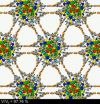(Press-News.org) Your body's cells have two major interconnected energy sources: the lipid metabolism and the glucose metabolism. Most cancers feed themselves by metabolizing glucose, and thus can be seen in Positron Emission Topography (PET) scans that detect radiolabeled glucose. However, prostate cancers tend to use the lipid metabolism route and so cannot be imaged in this way effectively. A University of Colorado Cancer Center study being presented today at the American Association for Cancer Research (AACR) Annual Meeting 2014 describes a novel method to "manipulate the lipid metabolism in the cancer cell to trick them to use more radiolabeled glucose, the basis of PET scanning," says Isabel Schlaepfer, PhD, investigator at the CU Cancer Center Department of Pharmacology, and recipient of a 2014 Minority Scholar Award in Cancer Research from AACR.
The current study used the clinically safe drug etomoxir to block prostate cancer cells' ability to oxidize lipids. With the lipid energy source removed, cells switched to glucose metabolism and both cells and mouse models roughly doubled their uptake of radiolabeled glucose.
"Because prostate cancer can be a slow-growing disease, instead of immediate treatment, many men choose active surveillance – they watch and wait. But that requires repeated prostate biopsies. Instead, now we could use this metabolic technique to allow PET imaging to monitor prostate cancer progression without the need for so many biopsies," says Schlaepfer.
Schlaepfer also points out possible therapeutic application of the technique: while immediately useful for imaging, it may be that cutting off a prostate cancer cell's ability to supply itself with energy from lipids could make it difficult for these cells to survive.
INFORMATION:
The University of Colorado Cancer Center is currently recruiting participants for a human clinical trial of the fat-burning inhibitor ranolazine to enhance PET imaging during the active monitoring of prostate cancer (NCT01992016).
Non-invasive imaging instead of repeated biopsy in active monitoring of prostate cancer
2014-04-06
ELSE PRESS RELEASES FROM THIS DATE:
Researchers find that renal cancer cells thrive when put in the right environment and supported by a specific enzyme
2014-04-06
SAN DIEGO, CA (April 6, 2014)—Tumor cells are picky about where they live. In the wrong environment, they fail to reach their potential. But put those same cells on the right bit of real estate, and they grow like mad. Researchers at Fox Chase Cancer Center found renal cancer cells planted in a supportive environment proliferate with the help of an enzyme usually only seen in the brain.
The enzyme, a specific isoform of a rather common kinase, may eventually become a target for cancer therapy as kinases constitute reasonably targetable enzymes, said Edna Cukierman, PhD, ...
Scripps Research Institute scientists provide new grasp of soft touch
2014-04-06
LA JOLLA, CA—April 6, 2014—A study led by scientists at The Scripps Research Institute (TSRI) has helped solve a long-standing mystery about the sense of touch.
The "gentle touch" sensations that convey the stroke of a finger, the fine texture of something grasped and the light pressure of a breeze on the skin are brought to us by nerves that often terminate against special skin cells called Merkel cells. These skin cells' role in touch sensation has long been debated in the scientific community. The new study, however, suggests a dual-sensor system involving the Merkel ...
Amino acid fingerprints revealed in new study
2014-04-06
VIDEO:
This animation shows the basic process of sequencing amino acids in a nanopore, using the technique of recognition tunneling.
Click here for more information.
Some three billion base pairs make up the human genome—the floor plan of life. In 2003, the Human Genome Project announced the successful decryption of this code, a tour de force that continues to supply a stream of insights relevant to human health and disease.
Nevertheless, the primary actors in virtually all ...
Scientists find potential drug targets in deadly pediatric brain tumors
2014-04-06
BOSTON, MA (April 6, 2014) -- Researchers studying a rare, always fatal brain tumor in children have found several molecular alterations that drive the cancer, according to a new study from scientists at Dana-Farber/Boston Children's Cancer and Blood Disorders Center and McGill University. The findings identify potential new targets for drug treatments.
The new research could help physicians choose targeted agents with a better chance of combating pediatric high-grade astrocytomas, which are extremely difficult to treat with radiation and surgery. The tumors have resisted ...
Field study shows why food quality will suffer with rising CO2
2014-04-06
For the first time, a field test has demonstrated that elevated levels of carbon dioxide inhibit plants' assimilation of nitrate into proteins, indicating that the nutritional quality of food crops is at risk as climate change intensifies.
Findings from this wheat field-test study, led by a UC Davis plant scientist, will be reported online April 6 in the journal Nature Climate Change.
"Food quality is declining under the rising levels of atmospheric carbon dioxide that we are experiencing," said lead author Arnold Bloom, a professor in the Department of Plant Sciences.
"Several ...
Researchers find arid areas absorb unexpected amounts of atmospheric carbon
2014-04-06
PULLMAN, Wash.—Researchers led by a Washington State University biologist have found that arid areas, among the biggest ecosystems on the planet, take up an unexpectedly large amount of carbon as levels of carbon dioxide increase in the atmosphere. The findings give scientists a better handle on the earth's carbon budget—how much carbon remains in the atmosphere as CO2, contributing to global warming, and how much gets stored in the land or ocean in other carbon-containing forms.
"It has pointed out the importance of these arid ecosystems," said R. Dave Evans, a WSU professor ...
Friedreich's ataxia -- an effective gene therapy in an animal model
2014-04-06
The transfer, via a viral vector, of a normal copy of the gene deficient in patients, allowed to fully and very rapidly cure the heart disease in mice. These findings are published in Nature Medicine on 6 April, 2014.
Friedreich's ataxia is a severe, rare hereditary disorder which combines progressive neuro-degeneration, impaired heart function and an increased risk of diabetes. The condition affects one in every 50,000 birth. There is currently no effective treatment for this disease. In most cases, Friedreich's ataxia starts in adolescence with impaired balance and ...
Smoking visibility mapped for the first time
2014-04-06
The visibility of smoking in city streets has for the first time anywhere been mapped, in new research from the University of Otago, Wellington, New Zealand.
The research found that up to 116 smokers outside bars/cafés could be seen from any one location in the outdoor public areas of downtown Wellington (e.g. on a footpath). Of 2600 people observed in the outdoor areas of bars and cafés, 16% were smoking, with a higher proportion than this in evenings.
Data from observations across the downtown area were mapped by the researchers, producing a record of the street ...
Blood test could provide rapid, accurate method of detecting solid cancers
2014-04-06
STANFORD, Calif. — A blood sample could one day be enough to diagnose many types of solid cancers, or to monitor the amount of cancer in a patient's body and responses to treatment. Previous versions of the approach, which relies on monitoring levels of tumor DNA circulating in the blood, have required cumbersome and time-consuming steps to customize it to each patient or have not been sufficiently sensitive.
Now, researchers at the Stanford University School of Medicine have devised a way to quickly bring the technique to the clinic. Their approach, which should be broadly ...
Self-assembled superlattices create molecular machines with 'hinges' and 'gears'
2014-04-06
VIDEO:
This video shows the motion of nanoparticles in neighboring layers of the superlattice as pressure is applied.
Click here for more information.
A combined computational and experimental study of self-assembled silver-based structures known as superlattices has revealed an unusual and unexpected behavior: arrays of gear-like molecular-scale machines that rotate in unison when pressure is applied to them.
Computational and experimental studies show that the superlattice ...






